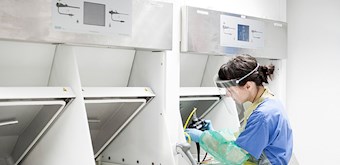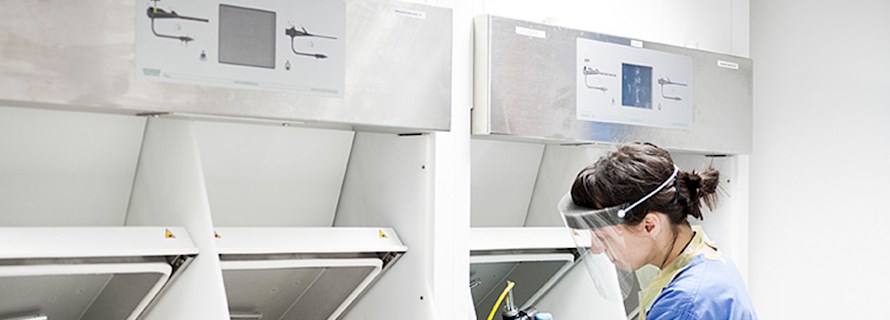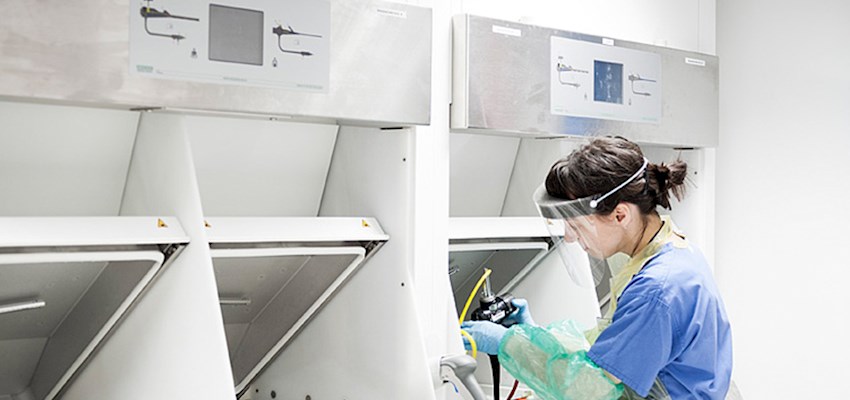Infection prevention and control
The human body is not sterile and from birth we become covered with bacteria (micro-organisms) known as ‘normal flora’. These normal flora are helpful and live harmlessly on or in the human body, but under certain conditions or given certain opportunities they can cause infections.
By their very nature, hospitals are places with high concentrations of people who are unwell, which can mean that they are more susceptible to infection. Alongside this many people come into hospitals who may have already picked up infections in the wider community.
By their very nature, hospitals are places with high concentrations of people who are unwell, which can mean that they are more susceptible to infection. Alongside this many people come into hospitals who may have already picked up infections in the wider community.
What we do to safeguard against infections
We have robust measures in place in our hospitals to minimise risk and prevent infection.
Responsibility for infection prevention and control belongs to Director of Infection Prevention and Control who is the Chief Nursing Officer, supported by the Head of Infection Control and the Infection Control Nurse Leads and Infection Control Doctors. This team work to ensure that across our hospitals we have measures in place to minimise the infection risk to patients, staff and visitors.
Responsibility for infection prevention and control belongs to Director of Infection Prevention and Control who is the Chief Nursing Officer, supported by the Head of Infection Control and the Infection Control Nurse Leads and Infection Control Doctors. This team work to ensure that across our hospitals we have measures in place to minimise the infection risk to patients, staff and visitors.
Key aspects of infection prevention and control
-
Surveillance icon plus
By tracking and recording our rates of infection we can understand what we can do to improve.
Surveillance provides good information to patients and clinicians and is the cornerstone of infection control. Surveillance can:
- serve as an early warning system
- document the impact of an intervention
- track progress towards specified goals
-
Hand hygiene icon plus
- Standard infection control precautions underpin routine safe practice, protecting both staff and patients from infection. They include hand hygiene, appropriate use of personal protective equipment, safer sharps practices, risk assessment and decontamination of medical devices.
- Good hand hygiene is one of the most important elements in reducing transmission of infectious agents, during delivery of care. It is a process to remove potentially harmful micro-organisms from the skin by effective, timely hand hygiene: reducing the risk of cross-infection to our patients, staff and others
-
Environmental cleanliness icon plus
The environment and equipment used in the delivery of care must be managed appropriately to limit the risk of contamination from micro-organisms, which in turn, could potentially lead to the spread of infection. We ensure that our hospitals are cleaned to a high standard and meet national cleaning requirements. HCA UK also uses technology and innovation to support these processes, for example we use Hydrogen Peroxide Vapour to enhance our cleaning service. -
Patient screening icon plus
At our hospitals we undertake a range of screening for patients based on risk. Screening is a painless process and only takes five minutes; we simply take swabs from patients. We follow national guidance on any new screening requirements.
Understanding infection rate data
As a responsible healthcare provider, we are committed to being transparent about our infection rates and submit our data to both UK Health Security Agency (UKHSA) and the Private Healthcare Information Network (PHIN).
We report and track infection rates of the following:
- Meticillin Resistant Staphylococcus aureus (MRSA) bloodstream infections (BSI)
- Meticillin Sensitive Staphylococcus aureus (MSSA) BSI
- Escherichia coli (E coli) BSI
- Klebsiella species BSI
- Pseudomonas aeruginosa BSI
- Clostridioides difficile (C-diff) infection




HCA UK infection rate data
When looking at infection rates it is important to consider factors that may have had an impact on the numbers, for example, the patient case mix and complexity.
HCA UK’s infection rate data is comparable with the NHS who deliver similarly complex care.
Our rates can sometimes look higher than others in the independent sector because we specialise in in providing acute care for both adults and children and have the expertise and facilities to treat those patients with the most complex care needs.
In some cases, these complexities can also mean that these patients, because of their weakened immune systems, are more likely to pick up certain infections once in hospital than those who have stronger immune systems. For instance, having cancer or treatment for cancer can weaken your immune system and increase a patient’s risk of acquiring an infection[1.
HCA UK’s infection rate data is comparable with the NHS who deliver similarly complex care.
Our rates can sometimes look higher than others in the independent sector because we specialise in in providing acute care for both adults and children and have the expertise and facilities to treat those patients with the most complex care needs.
In some cases, these complexities can also mean that these patients, because of their weakened immune systems, are more likely to pick up certain infections once in hospital than those who have stronger immune systems. For instance, having cancer or treatment for cancer can weaken your immune system and increase a patient’s risk of acquiring an infection[1.
Community and hospital acquired infection rates
At HCA UK we screen patients to understand if they have already acquired an infection before being admitted to our care. This is called a community acquired infection.
Sometimes patients will acquire an infection in hospital. There are many reasons for this, including complexity of care and, despite all precautions, they may still get an infection. This is called a hospital acquired infection.
Understanding if an infection is community or hospital acquired is important to consider when looking at infection rate data.
The data we provide to PHIN and UKHSA is not spilt out between community and hospital acquired infections. For example, approximately 50% of the infection rate data submitted to PHIN by HCA UK were of community acquired infections, so infections picked up before the patient was admitted to our care.
Sometimes patients will acquire an infection in hospital. There are many reasons for this, including complexity of care and, despite all precautions, they may still get an infection. This is called a hospital acquired infection.
Understanding if an infection is community or hospital acquired is important to consider when looking at infection rate data.
The data we provide to PHIN and UKHSA is not spilt out between community and hospital acquired infections. For example, approximately 50% of the infection rate data submitted to PHIN by HCA UK were of community acquired infections, so infections picked up before the patient was admitted to our care.
[1] Cancer Research UK
